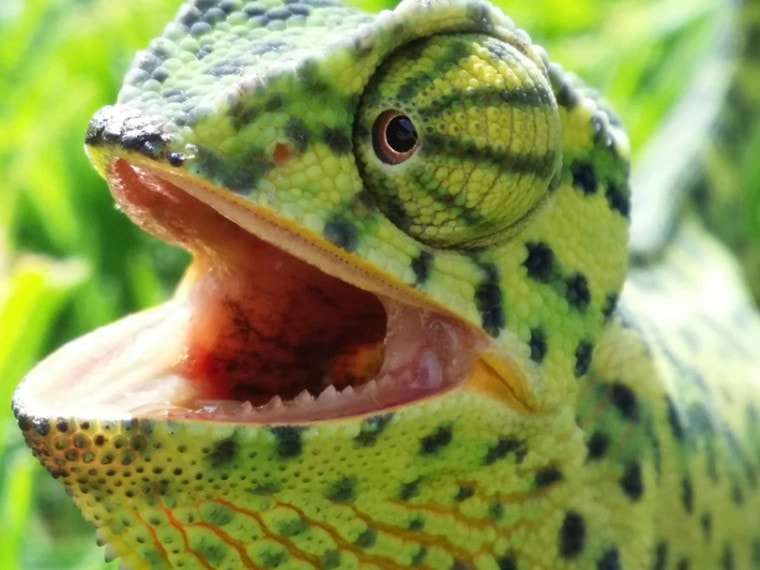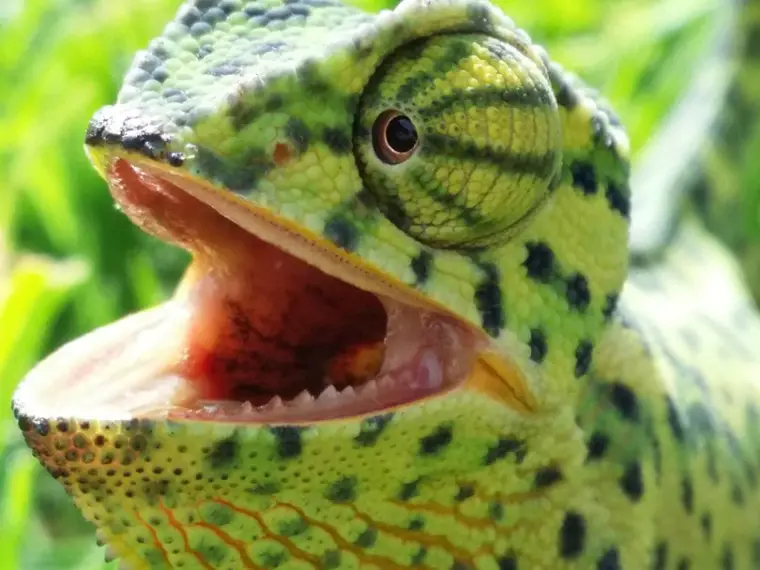Veiled chameleons are fascinating creatures that have a unique ability to change colors to blend in with their surroundings. But, have you ever wondered if they have teeth? The answer might surprise you.
Contrary to popular belief, veiled chameleons do have teeth. In fact, they have a lot of them! These tiny teeth are sharp and perfect for grabbing and holding onto prey. But, there’s more to the story than just teeth. Let’s dive deeper into the world of veiled chameleons and explore their dental anatomy.

Do Veiled Chameleons Have Teeth?
Veiled chameleons are fascinating creatures that have captured the attention of many reptile enthusiasts. These unique creatures are known for their ability to change color and their long, sticky tongues. However, one question that often arises about veiled chameleons is whether or not they have teeth. In this article, we will explore the answer to this question in detail.
Veiled Chameleon Anatomy
Veiled chameleons are a species of chameleon that is native to Yemen and Saudi Arabia. They are one of the largest species of chameleons, with males reaching up to two feet in length. Veiled chameleons have a unique anatomy that enables them to live in trees and other high places. Their feet are specially adapted for gripping branches, and their eyes can move independently of each other, giving them a 360-degree view of their surroundings.
Veiled chameleons also have a long, prehensile tail that they use for balance and stability. Their bodies are covered in small, overlapping scales that give them a rough texture. However, despite their unique features, one of the most interesting aspects of veiled chameleon anatomy is their teeth.
Do Veiled Chameleons Have Teeth?
Yes, veiled chameleons do have teeth, but they are not like the teeth that humans and other mammals have. In fact, the teeth of veiled chameleons are more like tiny spines or needles. They are not designed for chewing or grinding food, but rather for gripping and holding onto prey.
Veiled chameleons are carnivores and eat a diet that consists mainly of insects. When they catch their prey, they use their long tongues to capture it and their teeth to hold onto it. Their teeth are sharp and pointy, which allows them to penetrate the exoskeletons of their insect prey and hold onto them tightly.
The Benefits of Veiled Chameleon Teeth
The teeth of veiled chameleons may seem small and insignificant, but they play a crucial role in their survival. Without teeth, these creatures would not be able to hold onto their prey and would have a difficult time catching food. Their teeth are also important for defense, as they can use them to bite and defend themselves from predators.
Another benefit of veiled chameleon teeth is that they are constantly regenerating. Like other reptiles, veiled chameleons shed their teeth periodically throughout their lives. This means that they always have a fresh set of teeth that are sharp and ready to use.
Veiled Chameleon Teeth vs. Human Teeth
While veiled chameleon teeth serve a crucial purpose for these creatures, they are very different from human teeth. Human teeth are designed for chewing and grinding food, and they are much larger and more complex than chameleon teeth. Humans also have different types of teeth, including incisors, canines, and molars, which are specialized for different functions.
In contrast, veiled chameleon teeth are all the same size and shape, and they are not designed for chewing or grinding. They are simply used for gripping and holding onto prey. While the teeth of veiled chameleons may seem simple and basic, they are perfectly suited for the unique lifestyle of these creatures.
Conclusion
In conclusion, veiled chameleons do have teeth, but they are not like the teeth that humans and other mammals have. Their teeth are more like tiny spines or needles, which are used for gripping and holding onto prey. While they may seem simple and unremarkable, these teeth play a crucial role in the survival and wellbeing of veiled chameleons. Understanding the anatomy and behavior of these fascinating creatures is essential for anyone who wants to keep them as pets or learn more about them.
Frequently Asked Questions
Veiled chameleons are fascinating creatures that many people love to keep as pets. However, not everyone knows everything about them. One of the most common questions that people ask about veiled chameleons is whether or not they have teeth. In this article, we will answer this and four other questions related to veiled chameleons.
Do veiled chameleons have teeth?
Yes, veiled chameleons do have teeth. Their teeth are small and pointed, and they are situated in their upper and lower jaws. Veiled chameleons use their teeth to catch and hold their prey. They are carnivorous animals and eat insects, so they need teeth to be able to chew their food properly. The teeth of veiled chameleons are not very strong, so they are not able to bite through hard objects.
Veiled chameleons have a unique way of catching their prey. They use their long tongue to catch insects, and then they move their eyes independently to look at the prey from different angles. This helps them to determine the best way to approach and catch their prey. Once they have caught their prey, they use their teeth to hold it in place while they chew it up and swallow it.
How many teeth do veiled chameleons have?
Veiled chameleons have many small teeth in their upper and lower jaws. They have around 80 teeth in total. Their teeth are not very strong, but they are sharp and pointed. The teeth of veiled chameleons are replaced throughout their lives, just like human teeth. As they get older, their teeth become less sharp, and they may lose some teeth due to wear and tear.
If you have a veiled chameleon as a pet, it is important to make sure that their teeth are healthy. You can do this by feeding them a diet that is high in calcium, as this will help to keep their teeth strong. You should also make sure that their enclosure is kept clean, as dirty conditions can lead to oral infections and other dental problems.
Can veiled chameleons bite humans?
Veiled chameleons are generally not aggressive towards humans, but they can bite if they feel threatened or scared. Their bites are not very strong, and they are not venomous. However, their teeth are sharp, so a bite from a veiled chameleon can be painful and can cause bleeding. If you are bitten by a veiled chameleon, you should clean the wound with soap and water and seek medical attention if necessary.
To avoid being bitten by a veiled chameleon, it is important to handle them carefully and gently. You should also make sure that they are not feeling stressed or scared, as this can lead to aggressive behavior. It is also important to give them plenty of space and to respect their boundaries.
What do veiled chameleons eat?
Veiled chameleons are carnivorous animals and eat a diet that consists mainly of insects. Some of the insects that they eat include crickets, mealworms, and waxworms. They also eat some small vertebrates, such as lizards and small birds. In the wild, veiled chameleons will eat whatever insects and small animals they can catch.
If you have a veiled chameleon as a pet, it is important to feed them a balanced diet that is high in calcium. You can do this by feeding them a variety of insects and small vertebrates, as well as fruits and vegetables. You should also make sure that their food is gut-loaded, which means that the insects have been fed a nutritious diet before being fed to your chameleon.
How often do veiled chameleons shed their skin?
Veiled chameleons shed their skin regularly throughout their lives. Young chameleons shed more often than adults, as they are growing more rapidly. On average, adult veiled chameleons shed their skin every 4-8 weeks. Before shedding, their skin will become dull and grayish in color, and their eyes may appear cloudy.
During the shedding process, veiled chameleons may become more lethargic than usual, as their energy is focused on shedding their skin. It is important to make sure that their enclosure is clean and that they have access to plenty of water during this time. You should also avoid handling them too much, as this can cause stress and may delay the shedding process.
Female veiled chameleon showing off her teeth
In conclusion, we can confirm that veiled chameleons do indeed have teeth. Although they are small and not visible from the outside, these teeth are vital for the chameleon to eat and survive in the wild.
While it may seem like a trivial question, understanding the anatomy and habits of animals is crucial for their conservation and protection. By learning about the teeth of veiled chameleons, we can better understand how to care for them in captivity and preserve their natural habitats.
So, the next time you see a veiled chameleon, remember that behind its gentle demeanor and colorful appearance lies a complex and fascinating creature with many hidden features, including a set of small but powerful teeth.


